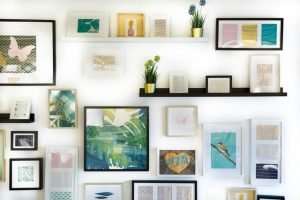Designer Tips for Decorating with Artwork: A blog about finding a good designer for your home.
Designing with artwork is all about balance and harmony. The most effective decorating styles often create a feeling of calm and tranquility by incorporating simple colors, textures, shapes and patterns. It’s not about the quantity of art you have hanging on your walls; it’s about the quality of the pieces that you select to display in your home.
Trying to create an atmosphere or ambience in your home can be difficult if you don’t know where to start. The process is just like any other design project – you have to start from the inside out. Start by taking stock of what you already have, then try adding in new items to complement them. Bright colors will bring life to dreary colors, but too many bright colors can leave a room looking cluttered.
Warm neutrals like beiges and tans are great for adorning blank walls and will give the room a more finished look when done right. Keep in mind that large pieces should always be balanced with smaller ones, so that there are no odd-looking empty spaces on the wall.
Having trouble finding artwork? Some homeowners avoid owning artwork because they don’t
Designer Tips for Decorating with Artwork
One of the most important things to remember when creating a living space is that different styles and combinations can clash. When people think of interior design and decorating they often think of being able to freely place art and other decorative items anywhere they want. While this is true, you need to keep in mind that each piece you choose has a style and tone to it, so you need to make sure that the pieces you select match your home’s overall style and design. If you want to create the perfect combination in your home, then hire a professional designer.
A professional designer will be able to help you find creative ways to place artwork in your home. In order for your wall art not to clash with what is already in your home, make sure you work with a professional who knows how different styles work together well or which ones do not mix well together. A professional will also be able to help you figure out the perfect way to display each piece of art in your home so that it looks great and complements the room it is in as well as the rest of the interior design elements in the room such as furniture, carpets, rugs, cabinets, etc. Since there are so many different pieces of art available
This article is a collection of tips I have learned over the years. I hope they will help you find the perfect designer for your home.
1. Do not be afraid to ask for referrals and references. Designers are more than happy to give them to you, and it can really help in your decision making process.
2. Ask about their design philosophy. What’s their process? How do they make decisions? Do they sketch out ideas or just jump right in on the computer? Understanding this will help you decide if their approach is what you’re looking for.
3. Ask to see 3-4 finished projects, with before and after pictures of each space (if possible). Is it what you are looking for? Did they provide good value for the cost? Did they make it easy on the homeowner by coordinating with other contractors such as painters, plumbers and electricians? Were they able to meet deadlines? Did they stick to the budget? Did they add any extra charges that weren’t part of the original contract?
4. Find out if they use subcontractors or assistants – if so, how much control do they have over who gets hired? Will they be involved in the selection process or will they just show up at the job site with a
Artwork is a wonderful way to add personality your space. But picking the right artwork can be tricky. Here are a few tips for decorating with art.
Tip 1: Choose two or more pieces that work together. A single piece of art can make a stunning statement, but creating a collection of pieces can be even more visually effective. For example, group photos of your family or several paintings of flowers in different sizes and colors.
Flowers are one of the easiest and most common ways to decorate with art, but you can also group pieces by color or theme. Posters created as part of an art series are another easy and eye-catching way to decorate with art.*
Tip 2: Make sure your art reflects your personality, not someone else’s. When picking out artwork for your home, do not choose something simply because you like it, but because it fits in with the style of your home. Ask yourself whether you would have liked it before you moved in, or if it feels like someone else’s taste instead of your own.*
Tip 3: Incorporate artwork into the rest of the room design.*
Tip 4: Don’t overdo it! Pick a few focal points in the room and make them pop using artwork.*
Welcome to Decorating with Art. My name is Joseph Lampley and I am the owner of the company that has been serving the greater Miami area since 2004. I’ve had a great deal of experience helping my clients find the perfect art for their homes, businesses, and public spaces.
I know you’ll find my blog useful and informative. Please feel free to contact me if you have further questions or concerns. I look forward to working with you!**
It is hard to believe that anyone still makes the mistake of thinking that interior design is only about choosing colors, picking paint schemes and furniture. The term has actually evolved to encompass so much more. It covers everything from choosing a theme to specific items, accessories and fabrics. Interior designers are more than just artists, they are experts on the latest trends in colors, materials and textures. They are able to choose colors that will complement each other without sacrificing style, taste or the look you want for your home.
How do you find a qualified interior designer? Well, there are certain things you should be looking for when hiring one. A good designer will have formal training in art as well as in architecture. An excellent designer will have at least three years experience in working with clients as well as an understanding of the principles of interior design.
It is also important to know what it is that you expect from your designer. Some people want someone who can make suggestions while others want someone who can take charge of the entire project from start to finish.
The best way to find a good designer is often through referrals from family members and friends who have hired them before and were happy with their work. You can also look for designers through word-of-mouth recommendations or through word-
We are well versed in the principles of home design. Now we will take a look at how to apply those principles to your practice. There is really no difference between designing a room for your house and designing a website for your business, as long as you maintain a solid grasp on the ultimate goal.
Design is no different from any other discipline that has a set of established rules and traditions. The rules are there to be broken, but only after careful consideration of their purpose and function. The question you need to ask yourself is “What will this design element do for my company?” or “What will it do for my business?” Just like with any other design element—be it an object, an advertisement, or something else—you have to consider the balance between form and function. Don’t let either become too dominant.
After all, creating an eye-catching form that fails to serve its function can actually harm your business. This may seem counter-intuitive, but it comes down to creating a proper hierarchy of elements that give your product or service the right emphasis. It’s up to you, though, to determine which elements deserve more attention by determining what they’ll ultimately add to your bottom line.*


